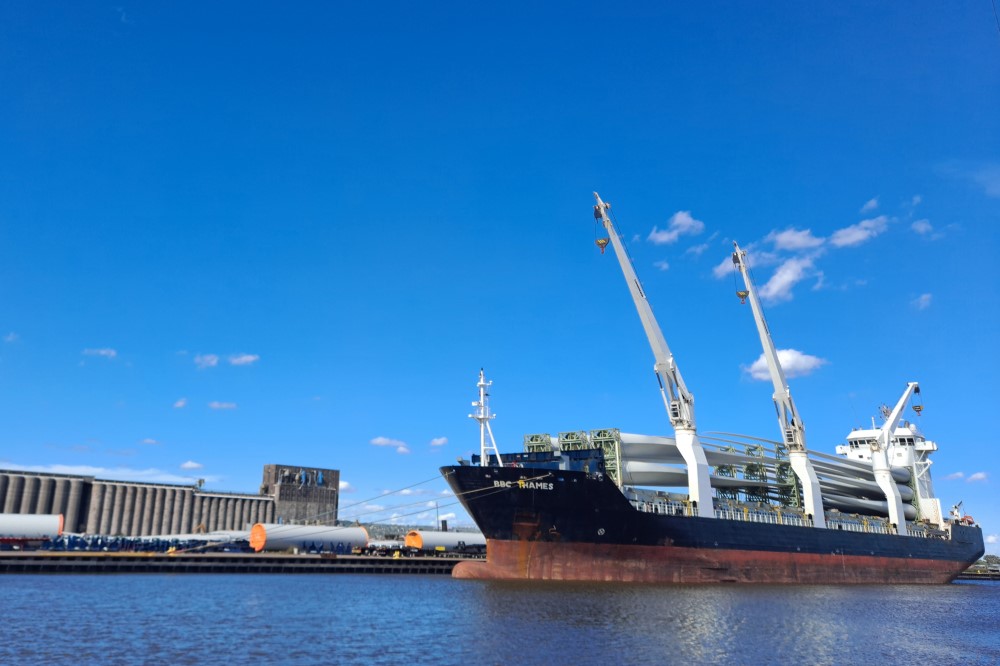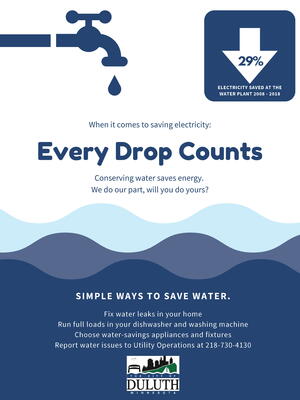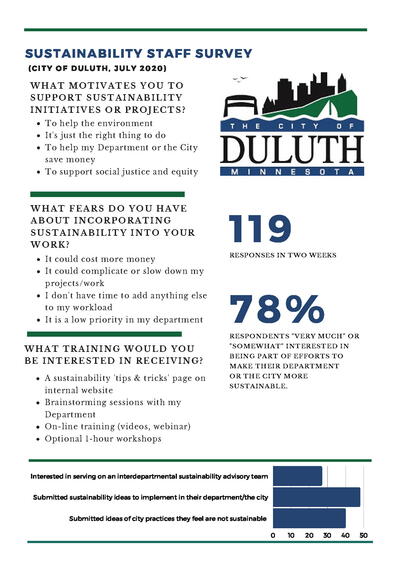
Our society, the economy, and the environment are all connected, and nowhere is this more visible than Duluth, Minnesota. Duluth is a bustling port city on the westernmost shore of Lake Superior, with miles of shoreline along the St. Louis River and Lake Superior, and over 11,000 acres of green space. Once a major hub of the iron industry, the regional economy still has an industrial base, but today Duluth provides a medical district for all of northeastern Minnesota and is also an important tourism destination within the Midwest.
With an abundance of natural resources and a reputation as an “outdoors city,” sustainability has long been present in city programs. Previous and current efforts include elimination of sanitary sewer overflows, creation of a Duluth Natural Areas Plan, improving access to the outdoors through impressive trail and park systems, a carbon reduction goal (80-percent reduction of carbon from city operations by 2050), the establishment of an Energy Fund, and participation in watershed outreach and education to protect our many streams and Lake Superior. However, the hiring of a sustainability officer is another step forward and clearly demonstrates a commitment to integration of environmental goals with economic and social systems. The position reports to the chief administrative officer, giving sustainability and resiliency a seat at the leadership team’s table.
There isn’t a detailed road map to follow for how to begin a sustainability effort within a community; however, there are several key elements needed for a strong start. Whether through a new position or a motivated internal team of collaborators, there are some common strategies to consider when creating sustainability goals and plans. This article will walk through four essential elements to help shape action around sustainability in any community:
- Vision and planning: find out what sustainability means for your community.
- Measurement and tracking: monitor progress to maintain momentum.
- Communication pathways: engage and unite city staff and the community.
- New opportunities: pursue projects and partnerships for sustainable change.
Vision and Planning: Find Out What Sustainability Means for Your Community
The challenges of sustainability are place-based, and so are the solutions. The sustainability officer position for the city was born from a conversation about what kind of a community our residents want to live in. Adopted in June 2018, the Imagine Duluth 2035 plan was an update to the city’s comprehensive plan, and it serves as a foundational element for defining and advancing our sustainability goals. Development took over a year and included the collection of resident and stakeholder ideas and priorities through both neighborhood and topical discussions. Imagine Duluth 2035 outlines several goals for the city (see Graphic 1) related to sustainability and resiliency, including strong representation in energy and conservation, affordable housing, jobs and a strong local economy, and open space preservation.
When it comes to climate change, each community will have to examine and learn about what their own vulnerabilities are and how to adapt to them. For Duluth, the state of Minnesota climatologist advise

A vulnerability assessment for Duluth1 recently outlined the climate impacts and expected vulnerable populations in our community, and provided recommendations for adapting to new climate realities. Being aware that the impacts of climate change will not be felt and distributed evenly across residents and neighborhoods is crucial to knowing where action is needed to protect the most vulnerable. This type of analysis will be key to identifying city priorities for climate action.
Identifying your city’s unique challenges is important when defining sustainability goals and plans, but there are likely numerous challenges that a great many communities all face, including aging infrastructure, affordable housing, and deferred maintenance of public buildings. And they may require finding new funding opportunities to solve.
When it comes to shared city infrastructure—water, stormwater, gas, district energy, streets, etc.—utilities are foundational to our safety and our economy. Adapting and maintaining our infrastructure will be a critical way to avoid impacts and damages from flooding and erosion during large storm events.
Improving and maintaining city infrastructure can also be a critical part of meeting sustainability and carbon reduction goals. Work to improve Duluth’s water distribution system over the past decade, including replacement of key water mains, resulted in significant electricity savings at the water plant: a 30-percent reduction from 2008 to 2018 (see Graphic 2).
One of the most visible examples of community infrastructure adaptation in Duluth is the Lakewalk, an eight-mile long paved pedestrian and bicycle trail, most of it along Lake Superior. The Lakewalk is nearly always busy with both locals and tourists out for a walk, run, or bike ride. Over the last several years, the paved trail and boardwalk have repeatedly sustained significant storm damage. Recently, the city council authorized staff to issue and sell $4.5 million in general obligation bonds to provide local matching funds for a three-phase project intended to make the Lakewalk more durable and resilient. Investment now to adapt this treasured pathway to the climate of our future, and not the climate of our past, will likely bring the benefit of savings in the long-term.
At its core, sustainability is about good governance: making values-based decisions about our resources, policies, and programs.
Measurement and Tracking: Monitor Progress to Maintain Momentum
Tracking and reporting is important for earning community buy-in, educating residents on sustainability and resiliency, and explaining how and why decisions impact greenhouse gas (GHG) emissions. Defining what metrics are needed for your community and building internal partnerships with staff to collect and access that data will significantly help inform decision-making. There are many types and levels of measurement and tracking activities that can be helpful. The following are some examples that we use in Duluth:
Minnesota GreenStep Cities
This state of Minnesota voluntary program makes tracking community metrics and sustainability goals easy. The web-based platform provides a detailed report of actions related to buildings and lighting, land use, transportation, environmental management, and resilient economic and community development.2
GHG inventory
Energy and water use, transportation data, and thermal district outputs are tracked by our energy coordinator, Alex Jackson. Currently, carbon emissions are tracked in a simple spreadsheet; however, to maintain consistency with accepted GHG reporting protocols, these data will soon be transferred into the Local Governments for Sustainability (ICLEI) ClearPath web-based calculator.
Monthly/annual reporting
Tracking sustainability progress can also be a simple addition to monthly or quarterly reports. For example, adding carbon emissions per unit of energy from the district thermal energy system’s monthly report, or adding electricity use (kWh) on a water utility’s annual report. These types of tracking are a simple way to monitor trends and raise visibility of issues with staff.
It is always exciting to celebrate a milestone. Duluth recently celebrated getting to Step 4 in MN GreenStep Cities, which means we are within the top 20 percent in program participants. We issued a press release and conducted media interviews3 to celebrate Duluth’s participation in the program and progress in our sustainability efforts.
Communication Pathways: Engage and Unite City Staff and the Community


Given the city’s ImagineDuluth 2035 vision and our natural resource-rich setting, it is crucial to address climate change and other environmental issues. Developing a communications plan to identify essential messages about sustainability challenges provides a framework for both internal and external communications. The motivations for including sustainability in city communications are to:
- Inspire: offer opportunities for residents to take sustainable actions, encourage community involvement in climate action.
- Inform: share our sustainability progress and challenges.
- Listen: gain feedback on sustainability from a broad group of stakeholders.
- Demonstrate: show commitment to integrating sustainability into decision-making and operations.
We are developing a website that will demonstrate our progress and share sustainability stories with the public. The website will act as a portal, providing resources for:
- Residents—guidance to reduce waste, save energy, and get involved locally.
- Visitors—offer suggestions to shop local and opportunities to get outdoors, including over 100 parks, 38 miles of cross-country ski trails, 85 miles of bike-optimized singletrack trail, and over 150 miles of hiking trails.
- Businesses—provide resources for technical assistance, need-to-know ordinances, and more.
Solid public engagement channels exist already to gather feedback and encourage participation from residents. However, new means and methods are being explored. Duluth has many active boards and commissions around topics related to sustainability, including an Energy Plan Commission, a Natural Resources Commission, and a Human Rights Commission. However, with added capacity in a sustainability officer position, we will have greater ability to both show up where the community is already organizing around sustainability. Along with inviting folks to be part of city processes, it is important for sustainability staff to listen and meet people on their home turf as well. Strong relationships with community groups and innovators, including nonprofits, local foundations, and university partners, create vital connections and can channel innovative ideas to city staff and departments.
To be successful in our efforts, sustainability will need to be part of every department’s work and culture. Communities don’t need one person working on one sustainability solution; we need lots of people motivated to work on a wide variety of solutions. The ability to create shared goals and strategies can be an exciting opportunity for many city staff. To help identify existing efforts and future opportunities, along with staff motivations around sustainability, we conducted a short sustainability staff survey, which garnered input from every department across the organization. The responses will inform our internal communications, projects, and programs. A brief summary of the survey responses is in Graphic 3.
New Opportunities: Pursue Projects and Partnerships for Sustainable Change
Sustainability has long been an important value within the Duluth community, and collaborations between numerous environmental and social systems–oriented nonprofits, three higher education institutions, several active community foundations, and an engaged Western Lake Superior Sanitary District have championed these efforts. Our local utility provider, Minnesota Power, has made investments in clean energy and is headed to 50-percent renewable energy by 2021. From 2009 to 2019, the Sustainable Twin Ports nonprofit worked to inspire action within the operations and strategy of local businesses and organizations.
Strong partnerships will be needed to achieve lasting change. Embrace the adaptive networks within the community. Often, nonprofit and foundation partners can be swifter and nimbler when working on sustainable change, and collaboration can help bring those ideas and pilot project results to integrate into the more rigid and systematic setting of city governance.

Partnerships within the community can also open up new opportunities for resources and capacity-building grants. Recent sustainability collaborations and leveraged resources in Duluth include:
Minnesota GreenCorps member for 2020–2021: The city was awarded a full-time college graduate for one year to assist on waste reduction projects and outreach, with particular focus on organics recovery and improving recycling at Bayfront Park.
An AmeriCorps VISTA member for 2020–2021: The city will host a full-time college graduate for one year to focus on equity issues and energy, building capacity, researching energy disclosure and benchmarking programs and policies, and assisting our gas utility’s Conservation Improvement Program staff in developing and delivering new outreach mechanisms.
Mellon Environmental Grant: As part of a project to develop local water education and outreach projects with an Indigenous culture and history lens, a partial salary stipend for city staff and funding for signage will be provided. The project is led by colleagues at the University of Minnesota Duluth in education, environmental science, and the medical school.
Great Lakes One Watershed: Relationships with staff from Minnesota Sea Grant, Ecolibrium3, the Duluth Superior Area Community Foundation, and the city of Duluth provided a pathway for two grant applications for infrastructure and neighborhood projects.
College and university partnerships: Short-term internships for class credit or course projects can help investigate sustainable opportunities. Interns from Lake Superior College and the University of Minnesota Duluth (UMD) helped develop initial stories and fact sheets about city sustainability efforts within the first six months, working with the sustainability officer. Coursework partnerships can also help; the Duluth Shines program connects students from UMD with local businesses and organizations to investigate energy and sustainability actions.4 The University of Minnesota Twin Cities also hosts a Climate Smart Municipalities program that connects city staff with colleagues from around the state and from German communities to accelerate progress toward a cleaner and more efficient energy footprint.
Although many of the partnerships above focus on short-term projects, they build critical long-term relationships between the city and local partners for sustainable change.
Start Smart for Maximum Impact
Every community will have different challenges and opportunities, and each will have to consider which actions, measurements, communications, and partnership opportunities they want to pursue. No matter what course you choose, integrating sustainability within your organization can reap multiple benefits. Whether you’re interested in saving money and resources over time, protecting open space, or building a more resilient economy, sustainability is about aiming to provide a high quality of life in a community for all of its residents.

Endnotes and Resources
1. Population Vulnerability Assessment and Climate Adaptation Framework, provided by the Minnesota Pollution Control Agency. https://static1.squarespace.com/static/53fbb928e4b0eafa4734317f/t/5b75b4238a922d0db065c8c6/1534440516909/Duluth+Vulnerable+Populations+Report+053118.pdf
4. Shines! University Engineering Students Advancing Duluth's Sustainable Development, https://www.liebertpub.com/doi/10.1089/sus.2017.0014
New, Reduced Membership Dues
A new, reduced dues rate is available for CAOs/ACAOs, along with additional discounts for those in smaller communities, has been implemented. Learn more and be sure to join or renew today!
